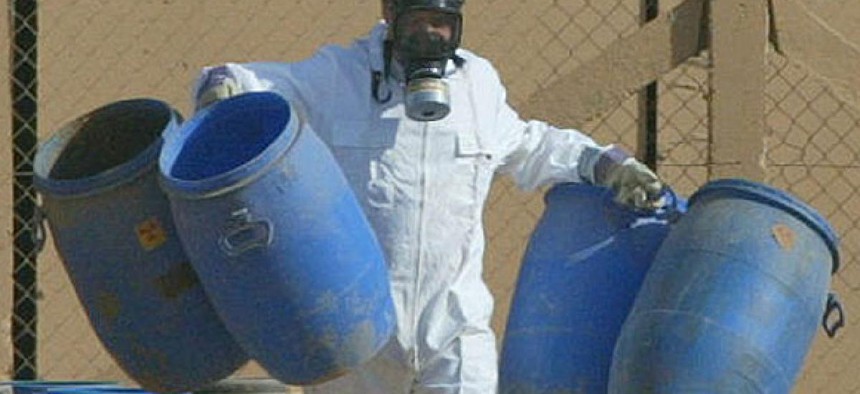White House Advances Controversial Nuclear Incident Response Guide

Bullit Marquez/AP file photo
New approach is expected to relax long-held cleanup standards.
The White House has cleared the way for a controversial guide on responding to nuclear incidents that is expected to relax long-held cleanup standards, prompting watchdog groups to call for Senate scrutiny of the matter during hearings on Gina McCarthy's nomination to become the next Environmental Protection Agency administrator.
The White House Management and Budget Office completed its review of the Environmental Protection Agency’s protective action guidance for radiological incidents on Friday, according to the OMB website. While the document is not yet public, it is widely expected to suggest cleanups do not have to comply with public health guidelines established during the 1980s by the EPA Superfund program.
One of the Obama administration’s first actions upon taking office in January 2009 was to halt publication of a Bush-era draft of the document.
The earlier version suggested people could drink water contaminated with radiation levels thousands of times above what the Environmental Protection Agency would normally allow following an incident such as a radiological “dirty bomb” attack or a nuclear power plant accident. It also embraced a loosely defined approach to cleanup called “optimization,” under which stakeholders would be permitted to develop unique remediation standards for a given incident rather than follow Superfund rules.
The Obama White House now backs optimization, according to a recently completed draft report sponsored by the Homeland Security Department. This has alarmed nuclear watchdogs, particularly since the report suggests optimization would permit annual radiation doses that could cause as many as one in about 20 people to develop cancer over a 30-year period. In a worst-case scenario, EPA rules do not typically allow a cancer risk greater than one in 10,000 during this time frame.
Given the findings of the DHS report, nuclear watchdogs say they expect the EPA guide will suggest that following its own Superfund rules is not necessary in all cases. A version of the EPA guide floated internally during President Obama’s first term included such language, and activists say the findings of the DHS report show the White House approves such statements.
Activists would have preferred that the EPA guide continue to languish in a state of perpetual review, but now that it has been cleared by the White House they are pushing the Senate to scrutinize the issue when it considers Gina McCarthy’s nomination to become the agency’s next administrator. McCarthy, who as assistant administrator for air and radiation was responsible for overseeing revisions of the guide, is due to appear before the Senate Environment and Public Works Committee on April 11.
“The responsibility is shared between the EPA officials who did not stand up for strong environmental protection and the White House which has been eager to show its tilt toward industry when it comes to environmental protection,” said Daniel Hirsch, president of Committee to Bridge the Gap, which led some 60 public interest groups against the Bush-era version of the guide in 2008.
A spokeswoman for Senate Environment and Public Works Committee Chairwoman Barbara Boxer (D-Calif.) did not respond to a request for comment. White House and EPA officials also did not respond to requests for comment by press time.
Activists, meanwhile, are calling for the private National Council on Radiation Protection, which organized the drafting of the report on optimization on behalf of the Homeland Security Department, to extend its public comment period for the document. The present deadline is Thursday, but activists are asking that it be pushed back 60 days after learning of it from reports in Global Security Newswire.
“It has just come to our attention that this extensive and potentially highly influential NCRP document is available for public review and comment,” 16 watchdog groups, including Physicians for Social Responsibility, Friends of the Earth and the Nuclear Information and Resource Service, said in a Monday letter. “It is clearly intended to serve as an influential recommendation that will affect the regulations that protect the public from ionizing radiation. To our knowledge, the public and public interest groups have not been included in the development of this document despite many of us actively interacting for decades in the issues it covers.”
Activists have previously raised concerns about the makeup of the panel that drafted the report. While the document discusses the Superfund cleanup approach extensively, no experts from the EPA office that works on the program directly were included on the panel. Instead, representatives of the agency’s radiation and emergency management offices – which have routinely argued against the Superfund approach – were selected to participate as consultants or advisers.
The draft report argues that the 2011 Fukushima disaster in Japan demonstrated that abandoning normal EPA standards is necessary in some cases. The DHS report says the disaster contaminated an area the size of Connecticut and, it claims, showed that cleaning up as thoroughly as the U.S. government usually requires would not be possible.
Activists have challenged this argument, noting that many dirty bomb scenarios the DHS report and the pending EPA guide address would affect areas substantially smaller than those traditional Environmental Protection Agency standards have been applied to in the past. The normal EPA benchmarks have been used at hundreds of sites, including nuclear weapons facilities owned by the Energy Department, mining grounds stretching across hundreds of square miles and the urban areas affected by the 2001 attacks on New York and Washington.
A major concern of not only activists, but also some EPA and state government officials, is the precedent a federal document allowing for relaxed remediation standards in a wide range of radiological scenarios could set for routine cleanups. Private companies and government officials are already arguing against using the Superfund approach at several radiological sites, including the Santa Susana Field Laboratory in California and an area of in central Florida where EPA officials fear some 40,000 people living on former phosphate mines may be exposed to dangerous levels of radiation.
NEXT STORY: Obama seeks funds to speed neurological research






